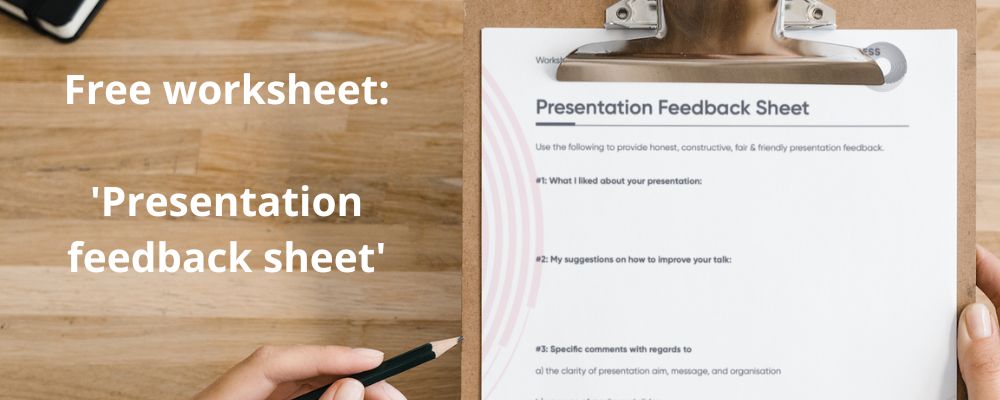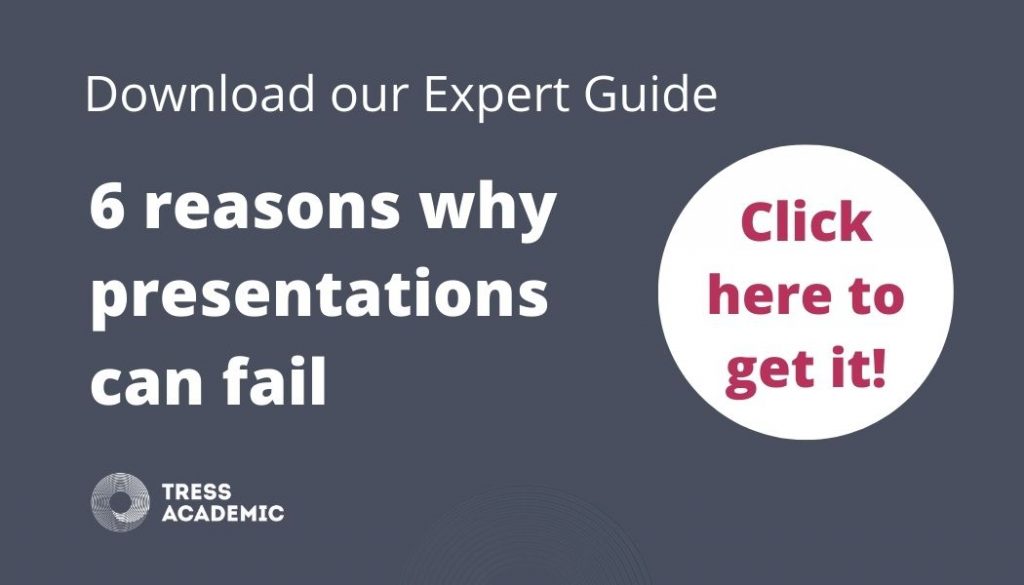Have you presented at a conference and found yourself wanting more useful feedback from the audience? Were you hoping the audience would recognise the hard work you put into your talk? We all need feedback to learn what we could improve to give a better presentation. Here, we would like to provide simple guidelines for presentation feedback at conferences.
In our courses, we teach researchers how to successfully present their work to their peers at conferences, and we also discuss the reasons why participants want to present at conferences at all. Not everyone enjoys giving presentations, and many soon realize that successful conference delivery requires investing a lot of time and effort.
Despite the potential discomfort or additional workload, one of the key motivations to present for many of our course participants is that they appreciate receiving feedback from their peers on their talks. But when they’re presenting at conferences, the desired feedback is seldom provided. And if feedback is expressed, it’s not in the way the presenters were hoping for. Have you had similar experiences?
Here, we aim to encourage anyone joining a conference talk to provide good feedback to the presenters and establish a feedback-culture. To help you provide such feedback, we’ve created a free Presentation Feedback Sheet to download that you can use the next time you join an event where colleagues will present their research.

I. What is presentation feedback?
First of all, it is a sign from the audience that they followed the presentation and have feelings they wish to express about it. They can signal admiration, support, agreement, disagreement, or any other reaction that might be helpful for the presenters. Feedback is not a critique of the talk. It is not meant to turn the presenters down or cast them in a bad light in front of their peers. Presentation feedback can include positive, negative, or neutral input—but it should always aim to be useful to the presenters.
Typically at conferences, a Q&A (questions and answers) session follows up the presenters’ talks. In the Q&A, the audience asks questions on the content, provides comments, or shares similar findings they’ve made. The Q&A should increase understanding of the presented research and help to embed it in a context familiar to the questioners and general audience.
Presentation feedback goes beyond the Q&A part of a talk. It’s more than someone from the audience requesting additional information from the presenter on a specific aspect of the talk. Feedback also addresses how a presentation is delivered, organised, structured, or composed. It includes technical, communicative, as well as didactic aspects. It allows for an emotional response to the talk and considers the entire performance of the presenters and the way they conveyed their message to the audience.
At academic conferences, Q&A and feedback can be mixed and come together. Yet, our own experience shows that most people from the audience prefer to ask questions to clarify or comment on a specific element of a talk rather than provide holistic feedback. Feedback is unfortunately not so common!

II. Why is feedback necessary?
Presenting at conferences can be quite nerve-wracking—particularly for early-career researchers and less-experienced presenters. Some told us that they are even more afraid of the Q&A at the end of their talks than of the talk itself. Even when they feel that they presented well, they’re afraid of receiving questions that they don’t understand and cannot answer. Balanced feedback, which may include a few questions, can provide a far better ending to a presentation for all involved.
We heard another example from one of our course participants who had recently prepared a talk for a conference. The delivery went well, but after the talk, there were neither questions asked nor feedback provided. It was silent, and then the chair went on to the next presentation. This silence felt very uncomfortable for the presenter. Understandably, it is awkward, if not down-right disappointing, to prepare a good talk, deliverwell, and have no one say anything about it. Was all the hard work a complete waste or not noticed?
We had a similar experience back in the years when we studied in Heidelberg. We had a class with a professor in urban climatology, his name was Heinz K. Every student in his class had to prepare a paper and deliver it to the class in a short presentation. When it was our turn, we both delivered two separate papers and presented them. We had put a lot of effort into the papers because the subject was so interesting and we enjoyed doing it. For every paper delivered in class, two fellow students had to prepare as opponents and present feedback.
Obviously, the fellow students who acted as our opponents were not living up to our professor’s expectations, as they hardly commented on anything. At the end of our session, the professor stood up and said “Doesn’t anyone realise that we just saw two excellent presentations?” And then he told the entire class why he thought we had done so well.
The feedback we got at this very moment from our professor was so helpful, inspiring, and an enormous motivation booster. It was so good to hear that he recognised the hard work we put into our papers. Receiving his feedback has taught us a lot and encouraged us to become even better. We still remember it, and wish everyone could receive feedback as we received it that day in Heidelberg!
For us, providing feedback on conference presentations serves four purposes:
1) Recognizing the work and time that presenters invested
All presenters want to deliver well and get their messages across, and everyone wants to have a positive impact on the audience. Some are more successful with this task than others, but all have that intention–otherwise they wouldn’t show up and present. Somehow the presenters need to know whether they were successful in this attempt or not, and feedback can provide that answer.
2) Preventing the post-presentation gap
Giving a presentation means being the centre of attention. All eyes are on the presenter during a presentation, and everyone is following every word and every visual being shown. Many presenters enjoy the lime-light, others not, but regardless, they have worked hard to prepare for it. But if the presentation is over and no feedback is expressed, and the audience just moves on to the next talk, the presenter falls into the post-presentation gap.
Nobody seems to notice them and if no one comes and talks to them, it can feel completely underwhelming or disappointing. Why did they then go through this exceptional and nerve-wracking process if their talk had no effect on anyone? It is frustrating for presenters to be ignored this way. It can happen all too easily at academic conferences: One presenter just follows the next one, and so on. Ideally, someone would tell the presenters how they honestly felt about their talk so that the presenter can see a purpose in the whole presenting exercise.
3) Providing helpful and critical input
In every presentation there are ups and downs, but it is difficult for the presenters to spot them themselves. Being in the audience and listening to the talk makes it easy to see immediately what worked well and what did not. You might assume the presenters know that as well, but they most likely are not aware of it. You’re of great help if you let presenters know what the good and not so good elements of their talk were. Then they can build on their strengths and work on the weak parts, and their next talks will be better! Otherwise, they will do the same the next time and you will also feel the same.
4) Establishing a relationship with the presenters
Providing feedback shows care for the person behind the presentation. If you liked their topic or the way they presented, giving feedback can be the first step in establishing a connection with them. You can wait and see how they behave offstage, and determine whether you would like to establish contact with them for future collaboration. Providing feedback is a great way to introduce yourself and begin a conversation with them about their work.
III. How to provide good feedback
It’s great that you are considering providing feedback to presenters in the first place, but you also want to ensure that your feedback is useful and well-received by the presenters. Here are some tips on how to do it right:
- Be constructive: Even if you didn’t like everything the presenter came up with, feedback is the wrong place to air your negative thoughts. Instead, the goal is to improve the situation so that the presenters do better the next time they are up on stage. Therefore, suggest realistic steps for improvement and offer your suggestions if possible.
- Be honest: If you did not like the talk, then don’t say it was a great talk. The presenters want to know how you really felt. You don’t need to give praise where it isn’t due, but that doesn’t mean you shouldn’t be friendly, kind, and supportive when you express less-positive feedback. But if you felt it was a great talk, then tell them, don’t be too modest!
- Be fair: It’s so easy to fall into a mode of criticising from your comfy seat in the audience, but are you being fair? Put yourself in the presenter’s situation, and consider which types of feedback you would like to recieve. Always express your feedback in a form and mode that is considerate and accounts for the speaker’s feelings. Treat them as you would like to be treated.
- Be timely: Provide feedback as close to the talk as possible. Then, you can still remember all the small details and the presenters can easily recall their talks.
- Be specific: A general comment like “Oh, it was a great talk” is good, but it is even more helpful when you can point out specific moments in the talk that were good. Or, point out what specifically the presenter could do to improve.
- Be careful in criticising publicly: Depending on where you provide your feedback, in private or in a larger group, provide critical comments in a personal exchange with the presenter rather than in a large group. Criticism can easily hurt the presenter, even if you did not intend it. It is easier for the presenters to take these comments in private, and you will likely have better results this way.
- Be modest: Whatever you say, make it clear this is YOUR specific view, your opinion. It is not helpful to claim something is generally wrong or right because different people may have different thoughts about it. Rather, say “I think you could try this way,” instead of saying “You should do it this way.”
- Don’t ‘but’: Avoid using sentences like “Overall it was a very good presentation but …” The negative turn wipes out all of the praise. The presenter only hears the ‘but’ and waits for the negative news. Rather, say “I think you gave a really good presentation because ….” Then continue with a separate statement where you could say “I think on this specific aspect it would be better to do it this way …”
- Be positive: Let the presenter know what was really good, and provide an example. End in a positive tone to leave the presenter motivated. After all, feedback is about encouragement!
Conclusion
Giving honest, fair and constructive feedback can raise the quality of presentations a lot. Feedback is not a judgement—good or bad—but an essential interaction and a learning process. Conferences are events where peers exchange, interact and learn from each other—they’re about communicating science. It is not a worthwhile experience if the only communication is from the presenters to the audience with no back-and-forth. When you give feedback to a presenter, you enable two-way communication, you pay them back for the time and effort they invested, and they will be grateful for it. Use our Presentation Feedback Sheet for your next conference and tell the presenters what you liked about their talks. By the way, even so-called “experienced” presenters are grateful to receive feedback!

Resources:
- Worksheet: Presentation Feedback Sheet
- Smart Academics Blog post #26: First conference presentation? 17 life-saving tips
- Smart Academics Blog post #30:Questions from the audience you should be prepared to answer
- Smart Academics Blog post #95:Apply these 5 tips to improve any presentation
- Smart Academics Blog post #116: How to be a great conference chair—Part 1: Prepare and open the session
- Smart Academics Blog post #117: How to be a great conference chair—Part 2: Managing time, presenters and questions
More information
Do you want to present successfully at conferences?
If so, please sign up to receive our free guides.
Photo by Arif Kusuma on unsplash.com
© 2022 Tress Academic
